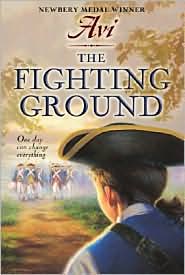
1. Bibliography:
Avi. 1884. The Fighting Ground. New York: HarperTrophy. ISBN: 9780064401852.
2.Summary:
Jonathan is a thirteen year old boy in America in the year 1778. Although he is young, he leaves his home one day to fight with the American forces. During his one day of service, Jonathan encounters enemy forces, learns about fighting, and a little about how all people are the same inside.
3. Analysis:
The book's set-up of having each section divided by time sets the scene for a young boy's daily routine. However, the day is anything but ordinary. Avi takes the reader for a journey into the personal day of a soldier in the Revolutionary War that is intriguing and very insightful to the daily life of the soldiers.
American students always hear that the soldiers in the American wars were young, but Avi drives the fact home by contrasting Jonathan's enthusiasm with his inept ability to perform. In the opening scene, Jonathan is ready to fight, even daydreaming about it. "His father's flintlock musket leaned against a stump. The cartridge box and powder horn were also there. The gun was primed, ready to be used. Jonathan knew how." These sentences show how Jonathan had been planning to help fight in the war and his confidence that he was equipped to fight. However, a few hours later, this confidence fades as he is "unsteady" and fails to load his gun quickly and accurately, revealing how most American boys were ill-prepared to fight.
American textbooks often idealize the American side of the war, but Avi gives a balanced approach. He shows the commander of the group to be a coward. He walks by Jonathan and does not really help. He only goes to the house to defeat the enemy after Jonathan heroically escapes with the young boy. He also shows the softer side of the enemy forces by having them not kill Jonathan and feed him instead.
In fact, it is the interaction with Jonathan with the Hessians that is the most compelling part of the book. Avi shows Jonathan's terror in the situation by not translating the Hessians' conversations. As the Hessians speak rapidly at Jonathan, the reader too feels confused and isolated. It is not until the end of the book that the reader realizes that the Hessians mean Jonathan no harm and want to "Let him go!" This interaction--Jonathan's saving the Hessians and their want to let him go free--show the most important theme of the book: that we are all human no matter what side of a war we are on.
4. Reviews:
Notable Children's Books of 1984 (ALA)
1984 Best Books for Young Adults (ALA)Notable
1984 Children's Trade Books in Social Studies (NCSS/CBC)
1984 Scott O'Dell Award for Historical Fiction for Children
5. Connections;
This book would be a great extended lesson in a history class. Because it's a quick read, it would be easy to read a little each day or to assign it as an extension homework assignment.

No comments:
Post a Comment